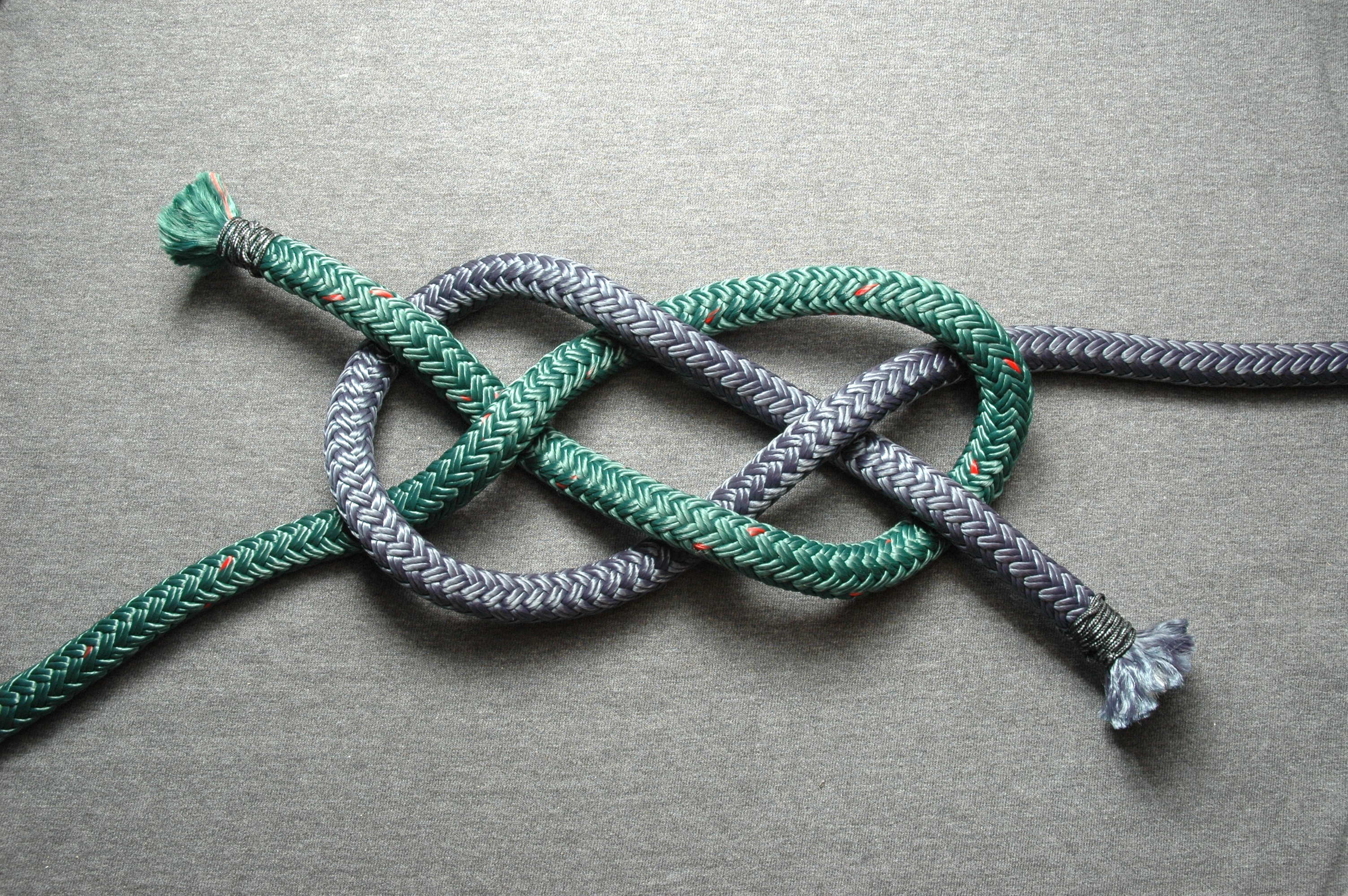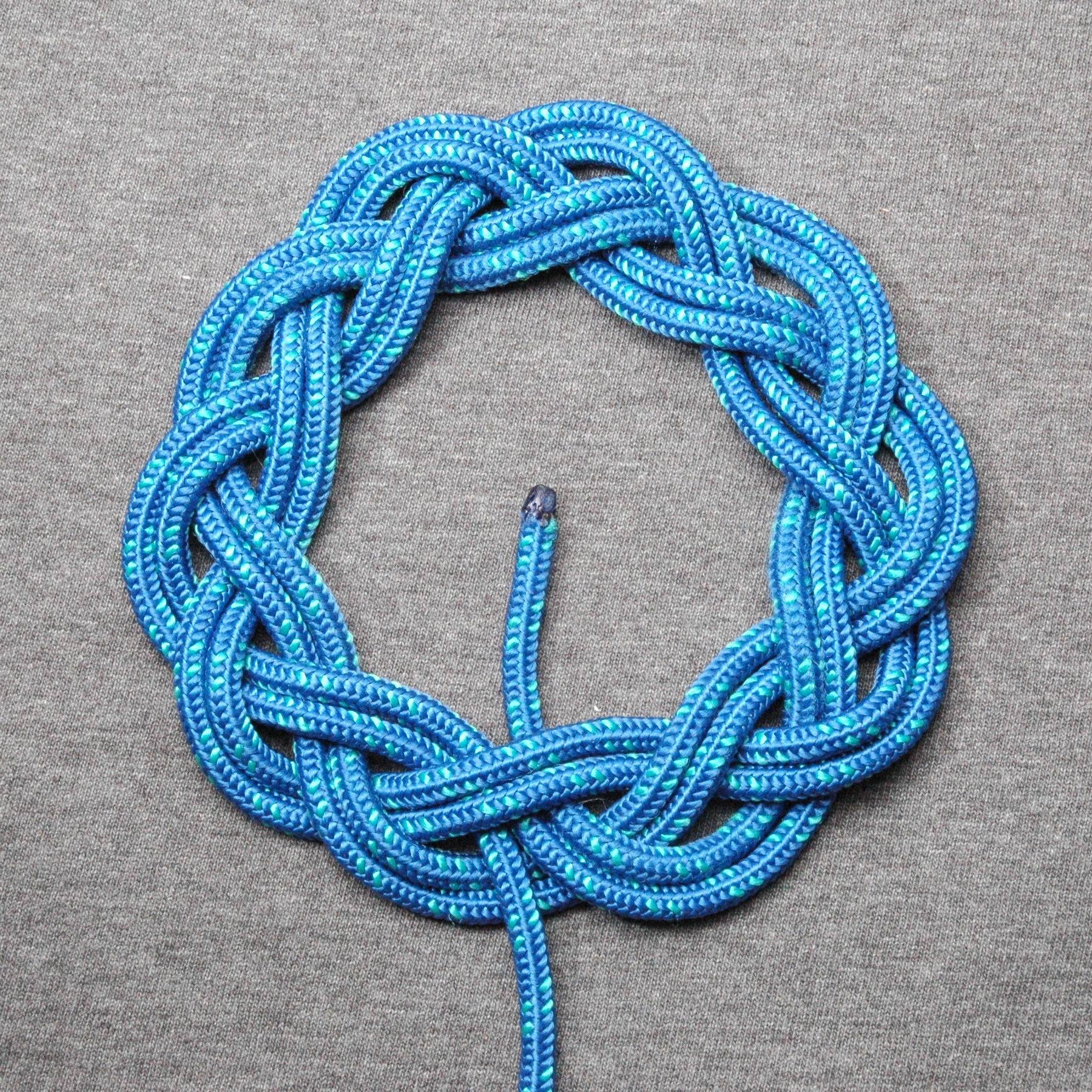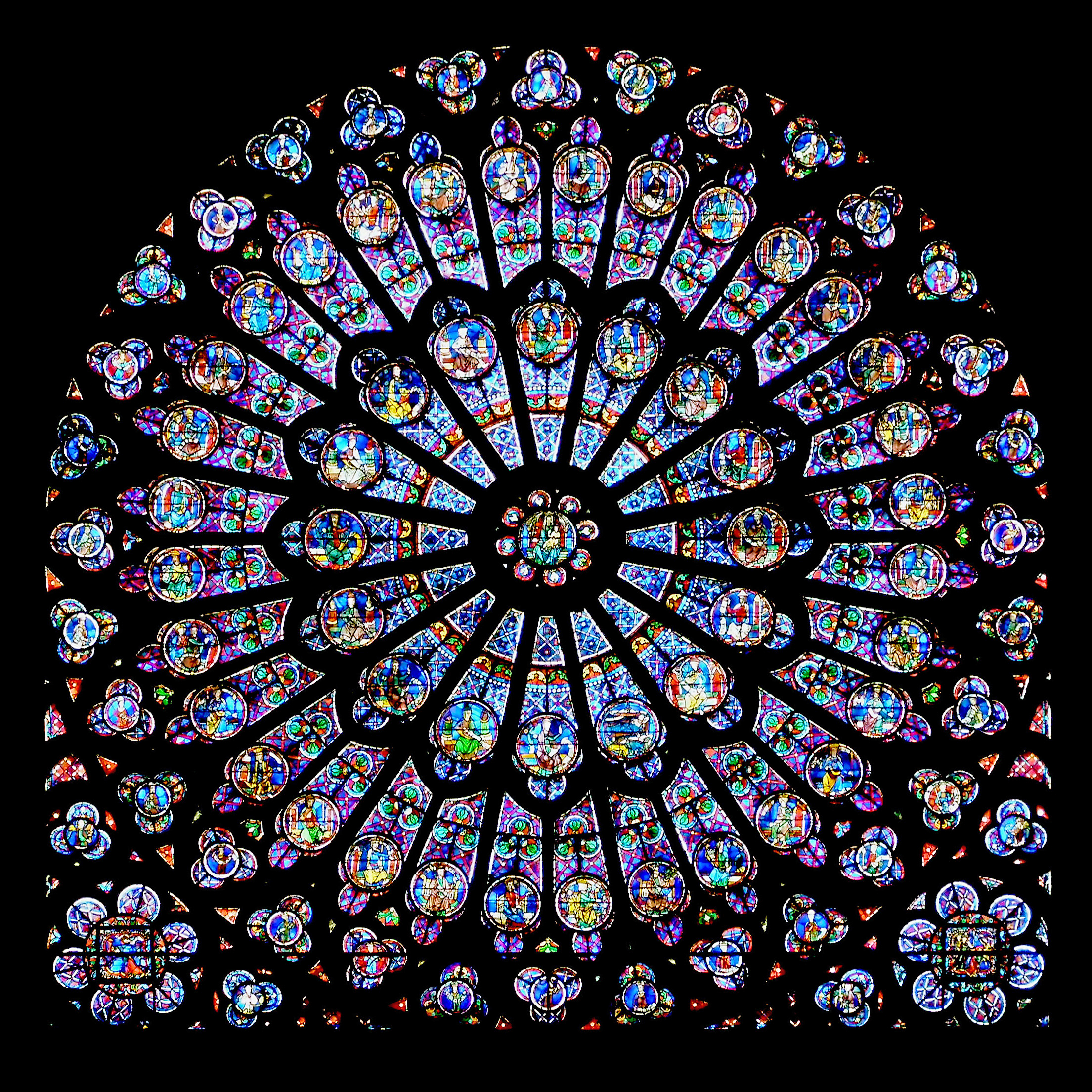|
Chinese Button Knot
The Chinese button knot is essentially a knife lanyard knot where the lanyard loop is shortened to a minimum, i.e. tightened to the knot itself. There emerges therefore only two lines next to each other from the knot: the beginning and the end. The knot has traditionally been used as a button on clothes in Asia, thus the name. Tying The basic chinese button knot (ABOK #599 on one string) is usually tied with a carrick bend that attaches the two ends as a first step. This results then in a knife lanyard knot (ABOK #787) where the loop part can be sized and used as a button hole, while the knot part can be used as a button. File:Knife-lanyard-knot-ABOK-787-Carrick-start.jpg, Tying starts with a diagonal carrick bend (two colors for clarity) File:Knife-lanyard-knot-ABOK-787-Over-standing.jpg, Ends continue around and over the standing part on the other side File:Knife-lanyard-knot-ABOK-787-Through-center.jpg, Ends under the knot and up through the middle hole together Fi ... [...More Info...] [...Related Items...] OR: [Wikipedia] [Google] [Baidu] |
Diamond Knot
The diamond knot (or knife lanyard knot) is a knot for forming a decorative loop on the end of a cord such as on a lanyard. A similar knot, also called the diamond knot, is a multistrand stopper knot, that is similar in appearance (although the footrope knot is really more similar, but it is simply an upside down diamond knot). To avoid confusion, it is advisable to call this knot the knife lanyard knot. This knot is a four strand diamond knot implemented in two strands. The knife lanyard knot is "tied alike" the Chinese button knot, "but they are worked differently."Ashley (1944), p.101. Tying The diamond knot begins as a Carrick bend with the ends exiting diagonally opposite each other. When the steps below are completed the knot is rearranged and tightened so that the ends emerge from the knot parallel and opposite their own standing part. A Chinese button knot is often tied in a very similar manner, but without leaving a loop at the end. Image:Knife-lanyard-knot-ABO ... [...More Info...] [...Related Items...] OR: [Wikipedia] [Google] [Baidu] |
Celtic Button Knot
A Celtic button knot is a stopper knot on a single rope that results in a spherical decorative knot with hair braid / basket weave pattern. It is essentially a single strand Turk's Head Knot that is structured such a way that it is effectively tied around the rope itself, creating a stopper. It typically is used as a button A button is a fastener that joins two pieces of fabric together by slipping through a loop or by sliding through a buttonhole. In modern clothing and fashion design, buttons are commonly made of plastic but also may be made of metal, wood ..., or as a knot securing the end of the rope from fraying. Tying There are 4 main steps to tying the Celtic knot: # two consecutive overhand loops, the last one placed partially over the first forming two petals of a four petal flower # left end woven from right horizontally through the loops; over, under, over, under forming the third petal # left end woven again from left: over the edge, under, under, ove ... [...More Info...] [...Related Items...] OR: [Wikipedia] [Google] [Baidu] |
Knife Lanyard Knot
The diamond knot (or knife lanyard knot) is a knot for forming a decorative loop on the end of a cord such as on a lanyard. A similar knot, also called the diamond knot, is a multistrand stopper knot, that is similar in appearance (although the footrope knot is really more similar, but it is simply an upside down diamond knot). To avoid confusion, it is advisable to call this knot the knife lanyard knot. This knot is a four strand diamond knot implemented in two strands. The knife lanyard knot is "tied alike" the Chinese button knot, "but they are worked differently."Ashley (1944), p.101. Tying The diamond knot begins as a Carrick bend with the ends exiting diagonally opposite each other. When the steps below are completed the knot is rearranged and tightened so that the ends emerge from the knot parallel and opposite their own standing part. A Chinese button knot is often tied in a very similar manner, but without leaving a loop at the end. Image:Knife-lanyard-knot-AB ... [...More Info...] [...Related Items...] OR: [Wikipedia] [Google] [Baidu] |
The Ashley Book Of Knots
''The Ashley Book of Knots'' is an encyclopedia of knots written and illustrated by the American sailor and artist Clifford W. Ashley. First published in 1944, it was the culmination of over 11 years of work. The book contains 3,857 numbered entries (the final number, "3854", is added to by three "1/2" #s (794.5, 1034.5, & 2585.5) and, in later editions of the book, #1425a for Hunter's Bend; and one number has no entry) and approximately 7,000 illustrations. The entries include knot instructions, uses, and some histories, categorized by type or function. It remains one of the most important and comprehensive books on knots. Use as a reference Due to its scope and wide availability, ''The Ashley Book of Knots'' has become a significant reference work in the field of knotting. The numbers Ashley assigned to each knot can be used to unambiguously identify them. This helps to identify knots despite local colloquialisms or identification changes. Citations to Ashley numbers are usual ... [...More Info...] [...Related Items...] OR: [Wikipedia] [Google] [Baidu] |
Carrick Bend
The Carrick bend, also known as the Sailor's breastplate, is a knot used for joining two lines. It is particularly appropriate for very heavy rope or cable that is too large and stiff to be easily formed into other common bends.Geoffrey Budworth, ''The Complete Book of Knots'' (London: Octopus, 1997), 43.Brion Toss, ''Chapman's Nautical Guides: Knots'' (New York: Hearst Marine Books, 1990), 79–80. It will not jam even after carrying a significant load or being soaked with water.Clifford W. Ashley, ''The Ashley Book of Knots'' (New York: Doubleday, 1944), 262–263. As with many other members of the basket weave knot family, the carrick bend's aesthetically pleasing interwoven and symmetrical shape has also made it popular for decorative purposes. Heraldry The Carrick bend is known as the " Wake knot" or "Ormonde knot" when it is used as a heraldic badge.Arthur Charles Fox-Davies, ''A Complete Guide to Heraldry'' (1909), p. 469. Etymology This knot's name dates back ... [...More Info...] [...Related Items...] OR: [Wikipedia] [Google] [Baidu] |
Turk's Head Knot
A Turk's head knot, sometimes known as a sailor's knot, is a decorative knot with a variable number of interwoven strands forming a closed loop. The name refers to a general family of knots, not an individual knot. While this knot is typically made around a cylinder, it can also be formed into a flat, mat-like shape. Some variants can be arranged into a roughly spherical shape, akin to a monkey's fist knot. This knot is primarily used for tightening up underlying material to overlay as a tubular covering knot, prevent slipping, and add a decorative element. A notable practical use for the ''Turk's head'' is to mark the "king spoke" of a ship's wheel (the spoke that is upright when the rudder is in a central position). The knot takes its name from its resemblance to a turban ( tr, sarık), though a turban is wound rather than interwoven. Leads and bights Different types of Turk's head knots are classified according to the number of leads and bights, as well as the method of ... [...More Info...] [...Related Items...] OR: [Wikipedia] [Google] [Baidu] |
Slip Knot
The slip knot is a stopper knot which is easily undone by pulling the tail (working end). The slip knot is related to the running knot, which will release when the standing end is pulled. Both knots are identical and are composed of a slipped overhand knot, where a bight allows the knot to be released by pulling on an end; the working end for a slip knot, and the standing end for a running knot. The slip knot is used as a starting point for crochet and knitting. Standard creation The slip knot is formed by first creating a loop in the shape of a "p". Place a hand or hook through the loophole and grab a bight on the working end. Draw this bight through the first loop. Seat the knot and pull the bight until a small loop is created. See also * Knot * List of knots This list of knots includes many alternative names for common knots and lashings. Knot names have evolved over time, and there are many conflicting or confusing naming issues. The overhand knot, for example, i ... [...More Info...] [...Related Items...] OR: [Wikipedia] [Google] [Baidu] |
Celtic Button Knot
A Celtic button knot is a stopper knot on a single rope that results in a spherical decorative knot with hair braid / basket weave pattern. It is essentially a single strand Turk's Head Knot that is structured such a way that it is effectively tied around the rope itself, creating a stopper. It typically is used as a button A button is a fastener that joins two pieces of fabric together by slipping through a loop or by sliding through a buttonhole. In modern clothing and fashion design, buttons are commonly made of plastic but also may be made of metal, wood ..., or as a knot securing the end of the rope from fraying. Tying There are 4 main steps to tying the Celtic knot: # two consecutive overhand loops, the last one placed partially over the first forming two petals of a four petal flower # left end woven from right horizontally through the loops; over, under, over, under forming the third petal # left end woven again from left: over the edge, under, under, ove ... [...More Info...] [...Related Items...] OR: [Wikipedia] [Google] [Baidu] |
Tangzhuang
Tangzhuang (), sometimes called Tang suit, is a kind of Chinese jacket with Manchu origins and Han influences, characterized with a mandarin collar closing at the front with frog buttons. It is an updated form of the Qing magua, itself a more fashionable adaptation of the riding jacket once worn by Manchu horsemen. Nowadays, the tangzhuang is one of the main formal clothing worn by Chinese men on various occasions; overseas Chinese also wear it as a form of fashion or to express their cultural identity. Name ''Tángzhuāng'' is the pinyin romanization of the Mandarin pronunciation of the clothes' Chinese name, written as in traditional characters and as in the simplified characters now used in mainland China. Its spelling may vary a little in other romanizations or dialects. It is also sometimes translated as a or jacket. ''China Daily'' (8 Feb 2002). Although the name of the jacket in English ''and'' Chinese suggests an origin during (or at least reference to) the Tang p ... [...More Info...] [...Related Items...] OR: [Wikipedia] [Google] [Baidu] |
Decorative Knots
Beauty is commonly described as a feature of objects that makes these objects pleasurable to perceive. Such objects include landscapes, sunsets, humans and works of art. Beauty, together with art and taste, is the main subject of aesthetics, one of the major branches of philosophy. As a positive aesthetic value, it is contrasted with ugliness as its negative counterpart. Along with truth and goodness it is one of the transcendentals, which are often considered the three fundamental concepts of human understanding. One difficulty in understanding beauty is because it has both objective and subjective aspects: it is seen as a property of things but also as depending on the emotional response of observers. Because of its subjective side, beauty is said to be "in the eye of the beholder". It has been argued that the ability on the side of the subject needed to perceive and judge beauty, sometimes referred to as the "sense of taste", can be trained and that the verdicts of experts ... [...More Info...] [...Related Items...] OR: [Wikipedia] [Google] [Baidu] |





